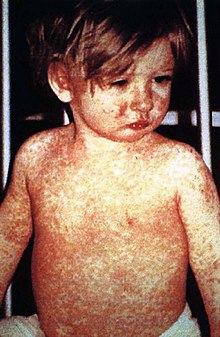| Measles | |
|---|---|
| Other names | Morbilli, rubeola, red measles, English measles[1][2] |
 | |
| A child showing a day-four measles rash | |
| Specialty | Infectious disease |
| Symptoms | Fever, cough, runny nose, inflamed eyes, rash[3][4] |
| Complications | Pneumonia, seizures, encephalitis, subacute sclerosing panencephalitis, immunosuppression, hearing loss, blindness[5][6] |
| Usual onset | 10–12 days after exposure[7][8] |
| Duration | 7–10 days[7][8] |
| Causes | Measles virus[3] |
| Prevention | Measles vaccine[7] |
| Treatment | Supportive care[7] |
| Frequency | 20 million per year[3] |
| Deaths | >200,000 (2019)[9] |
Measles is a highly contagious infectious disease caused by measles virus.[3][10] Symptoms usually develop 10–12 days after exposure to an infected person and last 7–10 days.[7][8] Initial symptoms typically include fever, often greater than 40 °C (104 °F), cough, runny nose, and inflamed eyes.[3][4] Small white spots known as Koplik's spots may form inside the mouth two or three days after the start of symptoms.[4] A red, flat rash which usually starts on the face and then spreads to the rest of the body typically begins three to five days after the start of symptoms.[4] Common complications include diarrhea (in 8% of cases), middle ear infection (7%), and pneumonia (6%).[5] These occur in part due to measles-induced immunosuppression.[6] Less commonly seizures, blindness, or inflammation of the brain may occur.[5][7] Other names include morbilli, rubeola, red measles, and English measles.[1][2] Both rubella, also known as German measles, and roseola are different diseases caused by unrelated viruses.[11]
Measles is an airborne disease which spreads easily from one person to the next through the coughs and sneezes of infected people.[7] It may also be spread through direct contact with mouth or nasal secretions.[12] It is extremely contagious–nine out of ten people who are not immune and share living space with an infected person will be infected.[5] People are infectious to others from four days before to four days after the start of the rash.[5] Most people do not get the disease more than once.[7] Testing for the measles virus in suspected cases is important for public health efforts.[5]
The measles vaccine is effective at preventing the disease, is exceptionally safe, and is often delivered in combination with other vaccines.[7][13] Vaccination resulted in an 80% decrease in deaths from measles between 2000 and 2017, with about 85% of children worldwide having received their first dose as of 2017.[12] Once a person has become infected, no specific treatment is available,[12] although supportive care may improve outcomes.[7] Such care may include oral rehydration solution (slightly sweet and salty fluids), healthy food, and medications to control the fever.[7][8] Antibiotics should be prescribed if secondary bacterial infections such as ear infections or pneumonia occur.[7][12] Vitamin A supplementation is also recommended for children.[12]
Measles affects about 20 million people a year,[3] primarily in the developing areas of Africa and Asia.[7] While often regarded as a childhood illness, it can affect people of any age.[14] It is one of the leading vaccine-preventable disease causes of death.[15][16] In 1980, 2.6 million people died of it,[7] and in 1990, 545,000 died; by 2014, global vaccination programs had reduced the number of deaths from measles to 73,000.[17][18] Rates of disease and deaths increased from to 2019 to 207,500 due to a decrease in immunization.[9] The risk of death among those infected is about 0.2%,[5] but may be up to 10% in people with malnutrition.[7] Most of those who die from the infection are less than five years old.[12] Measles is not known to occur in other animals.[12]